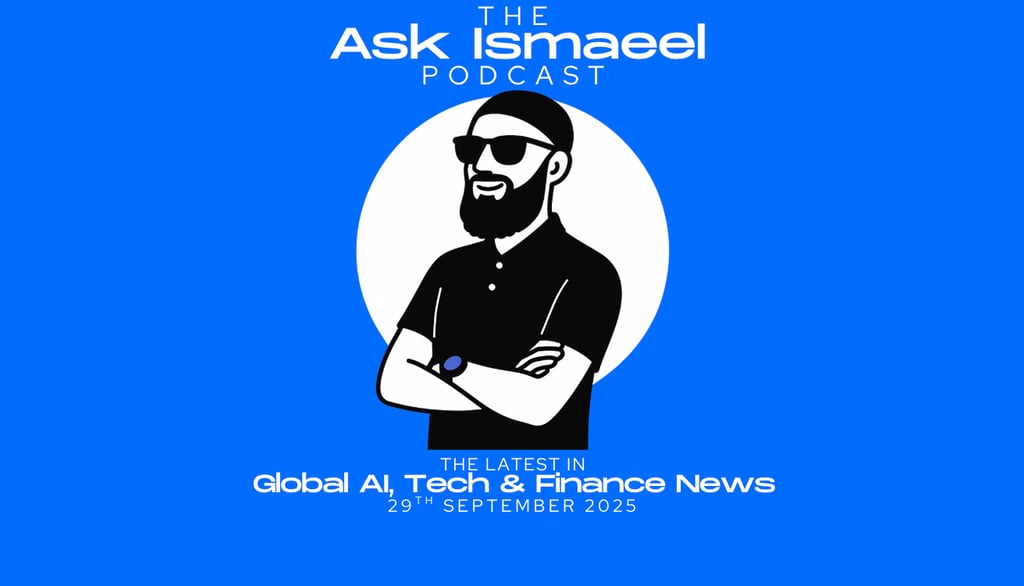Ask Ismaeel Podcast (Sept 29, 2025) — AI News, Tech Developments, Global Finance & Investing
Welcome to Episode — Sept 29, 2025 of the Ask Ismaeel Podcast, your weekly sharp, conversational breakdown of the latest global news in AI, tech, finance, and investing.
NEWSTECHNOLOGYFINANCEA.I - ARTIFICIAL INTELLIGENCE
9/29/20253 min read


The excitement surrounding artificial intelligence is undeniable, with a firehose of capital pouring into the industry at an unprecedented rate. From infrastructure to model development, the consensus is that AI represents the definitive next frontier in technology.
However, beneath the surface of this boom, a clear narrative is emerging about the fundamental economic forces and investor behaviors that will define the next phase of growth. This article unpacks three critical tensions, drawn from market analysis, that will shape the future of AI investing.
The Listicle: Three Key Takeaways
1. The AI Boom's Biggest Threat Isn't Competition—It's a Squeeze from the Bond Market
The capital commitment to AI is staggering, exemplified by Nvidia’s plan to invest up to $100 billion in OpenAI, supplying data-center chips and taking non-voting shares in a deal that further intertwines hardware and model power. This is part of a broader trend of companies pouring billions into the essential infrastructure of cloud services, chips, and data centers.
But a powerful economic headwind is emerging. Rising Treasury yields are increasing borrowing costs across the board, which in turn “squeezes margins” on these capital-intensive projects. This creates a direct conflict: the rising cost of capital is colliding with the sky-high upfront investment required for cutting-edge AI development.
This threat is surprising because it pits the old world of finance (interest rates) directly against the new world of tech. For a sector that spent a decade fueled by near-zero interest rates, this return to fundamental economics is a jarring reality check, proving that even revolutionary technology must answer to the cost of capital. Analysts now warn this dynamic could "slow the AI boom," and outlets like Breakingviews argue we are in an "AI investment bubble," where trillions are being invested with no guarantee of returns.
2. While Wall Street Is Anxious, Main Street Is Asking Chatbots for Stock Tips
One of the most remarkable trends projected to take hold is that 1 in 10 retail investors is now using a chatbot like ChatGPT to help pick stocks. This signals a deep and growing trust in AI for financial decision-making among individual investors.
This behavior stands in sharp contrast to the institutional market sentiment, which can be described as both "jittery" and "fragile." Caution is widespread among professionals, with both the S&P and Nasdaq losing ground for the week as uncertainty persists.
This creates a fascinating paradox: retail investors are showing increasing trust in the product of AI (chatbots) for financial advice, while institutional investors remain wary of the business of AI (growth stocks) as a safe investment in a high-rate environment. While Wall Street debates valuations, the retail trend is "turbocharging the robo-advisory market."
3. Fundamental Economics Are Forcing a "Flight to Safety," Even for Tech Investors
A significant shift is occurring in investment strategy, driven by high interest rates and uncertainty around potential rate cuts. This environment is forcing a broad market rotation as investors reassess risk.
Investors are moving away from "growth stocks," which are under pressure, and rotating into a "safer strategy." This approach prioritizes companies with proven quality, strong cash flows, and reliable dividends over speculative potential.
This is a critical takeaway because it demonstrates that even the most exciting technological revolution is not immune to fundamental economic principles. As institutional capital flows into traditionally defensive sectors like infrastructure and energy, it sends a powerful message. It’s a clear signal that for now, the guaranteed cash flows of an energy pipeline are winning out over the speculative promise of a next-generation neural network.
Conclusion: A Final Thought
These takeaways paint a nuanced picture of the AI landscape ahead. The industry faces real pressure from rising yields, a fascinating split is emerging between retail and institutional sentiment, and a broader market rotation back to financial fundamentals is taking hold. This complex reality will exist alongside the industry's undeniable technological progress.
As AI becomes more integrated into our economy, will it eventually become powerful enough to write its own economic rules, or will it always be subject to the timeless forces of interest rates and market sentiment?
Connect
Engaging digital strategies for your success.
Innovate
Inspire
© 2025. All rights reserved.